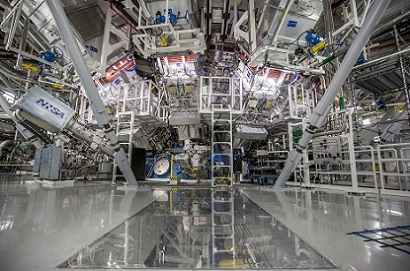Officials from the U.S. Department of Energy (DOE) announced that scientists at the National Ignition Facility (NIF) at Lawrence Livermore National Laboratory (LLNL) achieved fusion ignition, marking a groundbreaking advance in the decades-long quest toward a clean, limitless energy source.
Tuesday’s press event with U.S. Secretary of Energy Jennifer Granholm, Under Secretary of Nuclear Security and National Nuclear Security Administration (NNSA) administrator Jill Hruby, LLNL director Kim Budil, and other representatives confirmed earlier reports from major media outlets on Monday that the scientists achieved a “net energy gain” from a laser-powered, inertial confinement fusion reaction, producing more energy than the process consumed.
The successful experiment and fusion reaction input 2.05 MJ and released 3.15 MJ of energy, a higher threshold achieved than earlier indicated.* Though the controlled environment breakthrough does not offer an immediate bridge to the implementation of fusion power plants — which scientists believe would be much safer and greener than existing, fission-based nuclear power plants — the net gain achievement does mark a critical pathway to an inertial confinement fusion energy plant, Budil said.
“This is a landmark achievement for the researchers and staff at the National Ignition Facility who have dedicated their careers to seeing fusion ignition become a reality, and this milestone will undoubtedly spark even more discovery,” Granholm said, in a release issued before the press event.
An NIF team performed the experiment leading to ignition on Dec. 5** and obtained initial results that morning. The team then spent a week analyzing its results before publicly releasing the news. International media outlets led by London’s Financial Times shared news of the net gain before today, citing people close to the experiment.
Erasing Doubt
The successful Dec. 5 experiment follows a set of successes and setbacks at NIF dating to last year. In an August 2021 experiment, NIF scientists reported reaching the threshold of ignition — a world's first at the time and a yield of more energy than any previous inertial confinement fusion experiment. The experiment achieved an energy yield of 1.3 MJ, sufficient to re-create the extreme temperatures and pressures found at the heart of the sun.
In another important achievement in February, an NIF team tested a laser system in which fusion itself and not any external heating mechanism provided most of the heat needed for a fusion reaction.

The target chamber of LLNL’s NIF, where 192 laser beams delivered more than 2 million J of ultraviolet energy to a tiny fuel pellet to create fusion ignition on Dec. 5, 2022. Courtesy of LLNL.
This summer, however, NIF scientists failed to re-create last August’s experiment that brought them to the cusp of ignition — raising doubts about the NIF and its ability to spur ignition. Reports stated that the repeat attempts delivered no more than 50% of the energy output recorded in 2021.
According to Arthur Pak, who served as team lead for stagnation science and the lead for diagnostics on the Dec. 5 experiment, the NIF team attempted to repeat the 2021 experiment at least three times.
“What we learned from those experiments was that this design was still very sensitive to the target defects that were present,” Pak said. Team leaders on the experiment participated in a panel session following Tuesday’s press conference.
To generate a fusion reaction, the NIF’s 192 laser system fires a shot at a peppercorn-size target, heating hydrogen isotopes deuterium and tritium. The purity of the target, and any defects, has implications on experimental results.
“We were able to quantify and understand the origin of these defects,” Pak said. “And knowing that, we went for improved designs to make [the target] more robust. We used that knowledge to pick the best capsules to minimize the impact.”

Director of LLNL Kim Budil. Courtesy of LLNL.
Compared to earlier experiments, the target used in the Dec. 5 experiment featured considerable flaws, or defects, said Michael Stadermann, director of the Laboratory for Energy Applications for the Future at LLNL and the target fabrication program manager for the experiment. These included a number of so-called inclusions of tungsten, he said.
“Our pursuit of fusion ignition over the past decade at NIF was an incredibly ambitious technical goal,” Budil said. “Many said it was not possible.” She cited concerns over the energy of the NIF laser system, precision of the target, and performance capabilities of the teams’ modeling and simulation tools as those that the scientists addressed and met.
“Physics progress has taken time. But last August when we achieved a then record yield of 1.35 MJ, putting us at the threshold of ignition, many took notice. And last week, our pre-shot predictions, improved by machine learning and the data we have collected, indicated that we had a better than 50% chance of exceeding target gain.”
*Reports published prior to the U.S. DOE/LLNL press event cited people familiar with the development. Reports said that the reaction, then unconfirmed, produced about 2.5 MJ of energy, which was about 120% of the 2.1 MJ of energy in the lasers.
**The experiment that produced ignition occurred Dec. 5. August 2022 experiments, including those aimed at re-creating experiments that reached the threshold of ignition, did not yield the result shared by the DOE.